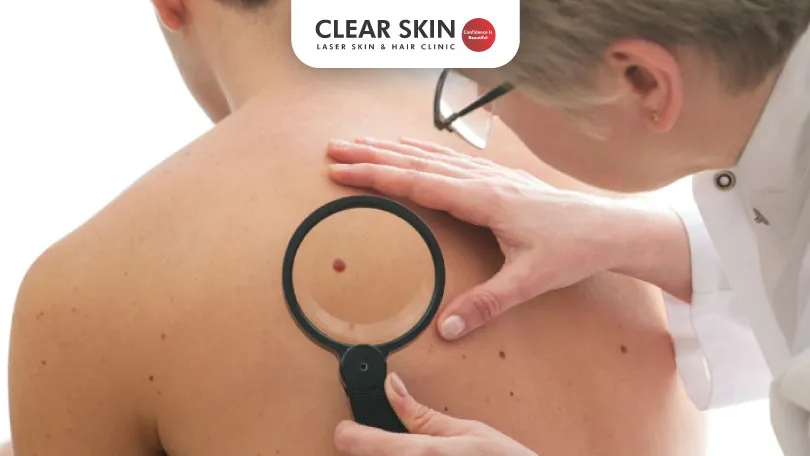All You Need To Know About Moles!
Reviewed By: Dr Dhananjay Chavan
Updated on: 23rd October, 2023

Moles, or nevi, are common skin growths formed by clusters of melanocytes, the pigment-producing cells. These growths can vary in color, shape, and size, and their development is influenced by factors such as genetics, sun exposure, and hormonal changes. Most moles are benign, but some can become cancerous, making it crucial to understand their types and characteristics.
Table Of Content
- What is Mole?
- Types of Moles
- When Should You Visit a Doctor?
- Differentiate: Cancerous or Non-Cancerous
- Skin Biopsy and Action Plans
- To Prevent Rather Than Cure
- Complication from Moles
- Conclusion
What is Mole?
A mole, medically known as ‘nevi’, is a growth generated from our skin that is pigmented. It can vary in color, from pink to black and everything in between. Melanocytes are skin cells that produce the pigment melanin. They are spread throughout our skin however they can grow in clusters thus forming moles. They are a raised spot on our skin.
Overexposure to the sun and the genetic construction of people play a major role. Fair people are susceptible to moles since they have lower levels of melanin. Teenagers and pregnant women can develop moles due to hormonal changes. The average adult has 10 – 40 moles.
Types of Moles
Common
These are dome-shaped smooth, and 5-6mm in diameter and have a distinct shape. They are pigmented and are found in people who are regularly exposed to the sun. Common moles can turn malignant but this is a rare occurrence.
Atypical
Atypical moles or dysplastic nevi are irregular. They are both raised and flat, fuzzy and blurry in appearance. They share signs that are similar to cancerous or malignant moles and individuals with a lot of atypical moles have an increased risk of forming cancerous moles.
Congenital
Congenital moles or congenital nevi are moles that you are born with. They are caused by melanocyte cells in the dermis-epidermis or both. The appearance of these moles varies and can turn cancerous as you move into your teenage and adult years.
Acquired
These moles pose little to no threat of cancer. They form as you enter your teenage and adult years.
Moles differentiated on the basis of location
Junctional Melanocytic Nevi
Melanocytes accumulated between the dermis and epidermis form these moles. As the years progress our melanocytes move to the deeper layers of our skin and as a result these type of moles form. They are raised, pigmented and have regular borders.
Intradermal Nevi
These aren’t as pigmented as the aforementioned moles since they are located in the dermis or middle layer of our skin. They are usually benign and form as we age.
Compound Nevi
A structure that has a central, raised portion with flattened yet distinct borders, formed between the dermis and dermo-epidermis junction comprises the evenly pigmented compound nevi.
Other Mole Types to Note
Halo Nevi
Inflammatory infiltrating cells around the mole form a lightened ring that mimics the ‘halo effect’.
When Should You Visit a Doctor?
- Most moles are benign or non-cancerous.
- Unusual moles or pigmented spots that arise as you move into adulthood call for a check-up.
- Older people have a higher risk. Genetics and exposure to UV rays have an impact too.
- Melanoma may arise from a previously normal mole or pigmented spot that has been present many years, however, these can appear randomly too.
- In comparison with benign (noncancerous) moles, melanoma moles tend to be larger, darker, and have more irregular color and shape variations.
- Most melanomas are actually not raised as many people tend to incorrectly assume.
Differentiate: Cancerous or Non-cancerous
A ‘regular mole’ has the following characteristics:
- Present anywhere on your skin, including your scalp, nails, and genitals
- Flat or raised
- Grow as the year’s progress and bulge outwards at an increasing rate
- Hair
- Develop during childhood until the age of 20
- Moles darken during times of hormonal change (adolescence, pregnancy, birth control pills)
However if their appearance changes in any way or
- They Bleed
- Itch
- Ooze
- Turn scale-like or flakey
- Become tender or painful;
Have
- Asymmetric shape (if you cut it in half and one side is different from the other)
- Irregular border (scalloped or ill-defined border)
- Uneven pigmentation
- Diameter exceeding 6mm, ¼ inch
- Evolving or changing mole;
A skin doctor should be consulted immediately to check for melanoma which is a type of skin cancer.
Skin Biopsy and Action Plans
- Normal moles: If your entire mole was not removed with the biopsy, some color may persist or recur at the location
- Abnormal moles: This includes a variety of terms including “atypical” or “dysplastic”. These moles are not cancerous and may or may not need to be removed. If removed, stitches might be required. Personalized treatment and check-up schedules are developed for patients with abnormal moles.
- Malignant moles: This refers to cancerous moles which must be removed immediately. Evaluation of lymph nodes during this period can provide useful information.
To Prevent Rather Than Cure
- Using sunscreens with SPF 50
- Using wide-brimmed hats
- Using sun-protective clothing (shirts, long sleeves, long pants)
- Avoiding overexposure to the sun from 10 a.m. to 4 p.m
- Seeking shade and staying indoors as age increases
- Monitor your moles by examining your skin carefully, including areas of skin not exposed to the sun, on a monthly basis
- Avoid tanning and do not use UV tanning booths
- Avoid burning
Complication from Moles
Melanoma is the main issue with moles. However, people born with several moles or unusual looking moles have a higher risk of melanoma.
- Being born with large moles: These types of moles are called congenital nevi. On an infant, such moles are classified as large if they’re more than 2 inches (5 centimeters) in diameter and could potentially turn cancerous as the child enters puberty.
- Having unusual moles: Irregular moles are known as atypical or dysplastic nevi. These are genetic and they often have dark brown centers and lighter, uneven borders. These are even called ‘halo moles’ due to this characteristic.
- Having a large number of moles: If you have over 50 normal moles on your body, you are highly susceptible to melanoma and must prevent it. People with 20 or more moles on their arms are at increased risk of melanoma. The number of moles on women’s bodies has shown to have a direct relation with breast cancer risk.
- Genetics: Some types of atypical moles lead to a genetic form of melanoma.
Do You Know?
Roughly 250 Patients Are Treated
Everyday By These Dermatologists
(You are one click away from flawless skin)
Meet Our Dermatologist!
Conclusion
Understanding the different types of moles and their potential risks is essential for maintaining skin health. While most moles are harmless, regular monitoring and sun protection are key to preventing complications such as melanoma. If you notice any changes in your moles, consult a dermatologist promptly for a thorough evaluation and appropriate care.
Further Reading
Do Acne Scar Removal Creams Really Work?
Discover do acne scar removal creams really work. Learn about the best ingredients and treatments to fade acne scars at Clear Skin Pune
Acne Pustules: How to Get Rid of Pustules?
Learn about causes, symptoms, and treatments from Dr. Dhanraj Chavan.
Is Tretinoin Cream Safe for Melasma? Tips and Usage Guide
Discover how tretinoin cream can safely treat melasma.
Unveiling the Potential of Face Packs for Acne Scars
Discover how homemade and customized face packs can help lighten acne marks and rejuvenate your skin.
Have thoughts? Please let us know
We are committed not only to treating you, but also educating you.






